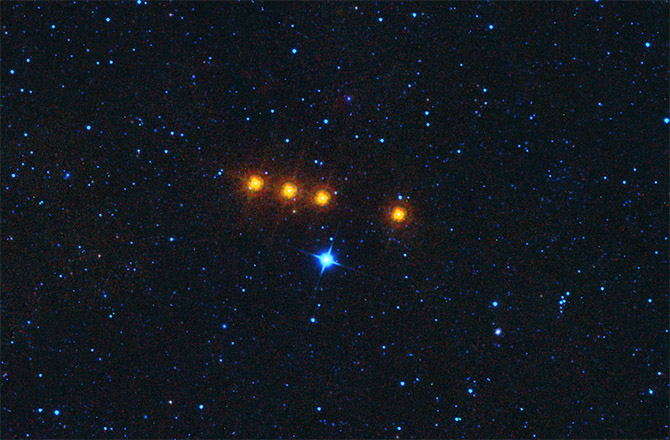Oddball Asteroid Outcasts Spied by Infrared Space Telescope

NASA's NEOWISE mission has tracked down an elusive family of asteroids that shun regular orbits in the asteroid belt, instead preferring a crazy roller coaster ride through the solar system's equatorial plane.
ANALYSIS: Russian Meteor: How Many Tiny Asteroids Buzz Earth?
These highly inclined asteroids are thought to be the product of a massive collision that fragmented a much larger asteroid, called Euphrosyne, some 700 million years ago. The impact, which is thought to be one of the last great impacts in the solar system's evolution, left the main 156 mile (260 kilometer) wide asteroid behind and a family of smaller chunks in this highly inclined orbital path. [Photos from NASA's WISE Space Telescope]
Euphrosyne is one of the ten largest asteroids to exist in the asteroid belt between the orbits of Mars and Jupiter.
The Euphrosyne family of asteroids are of great interest to astronomers tracking near-Earth objects (NEOs) — through a delicate resonance with Saturn's gravity, Euphrosynes have, in the future, the potential to drop into orbits closer to Earth.
ANALYSIS: NEOWISE Tracks 'Surprise' Comet as it Erupts
"The Euphrosynes have a gentle resonance with the orbit of Saturn that slowly moves these objects, eventually turning some of them into NEOs," said Joseph Masiero, of NASA's Jet Propulsion Laboratory (JPL) in Pasadena, Calif. and lead scientist on the Euphrosynes study, in a JPL news release. "This particular gravitational resonance tends to push some of the larger fragments of the Euphrosyne family into near-Earth space."
Get the Space.com Newsletter
Breaking space news, the latest updates on rocket launches, skywatching events and more!
Originally launched in 2009 to scan the whole infrared sky, the Wide-field Infrared Survey Explorer (or WISE) was retired in 2011 after running low on coolant. Now the WISE spacecraft has been re-booted to seek out NEOs in a mission called NEOWISE. It just so happens that the revived spacecraft is an ideal tool to find dark, high-inclination asteroids like the Euphrosynes.
ANALYSIS: NEOWISE is Back in the Asteroid Hunting Business
Masiero's team tracked and studied 1,400 Euphrosyne asteroids with NEOWISE, finding that they were large and dark with highly inclined and elliptical orbits.
With over 700,000 known objects in the asteroid belt , there are many more asteroids that have yet to be spotted. However, many are small and very dark, making surveys a very difficult task. NEOWISE, however, specializes in seeking out these hard to spot asteroids, identifying which ones occupy orbits that could, one day, encounter Earth. Characterizing the source of NEOs is therefore very important — a near-impossible task in the jumbled asteroid belt.
"Most near-Earth objects come from a number of sources in the inner region of the main belt, and they are quickly mixed around," said Masiero. "But with (the Euphrosyne family), in such a unique region, we are able to draw a likely path for some of the unusual, dark NEOs we find back to the collision in which they were born."
Source: NASA/JPL-Caltech
This article was provided by Discovery News.
Join our Space Forums to keep talking space on the latest missions, night sky and more! And if you have a news tip, correction or comment, let us know at: community@space.com.
Ian O'Neill is a media relations specialist at NASA's Jet Propulsion Laboratory (JPL) in Southern California. Prior to joining JPL, he served as editor for the Astronomical Society of the Pacific‘s Mercury magazine and Mercury Online and contributed articles to a number of other publications, including Space.com, Space.com, Live Science, HISTORY.com, Scientific American. Ian holds a Ph.D in solar physics and a master's degree in planetary and space physics.









